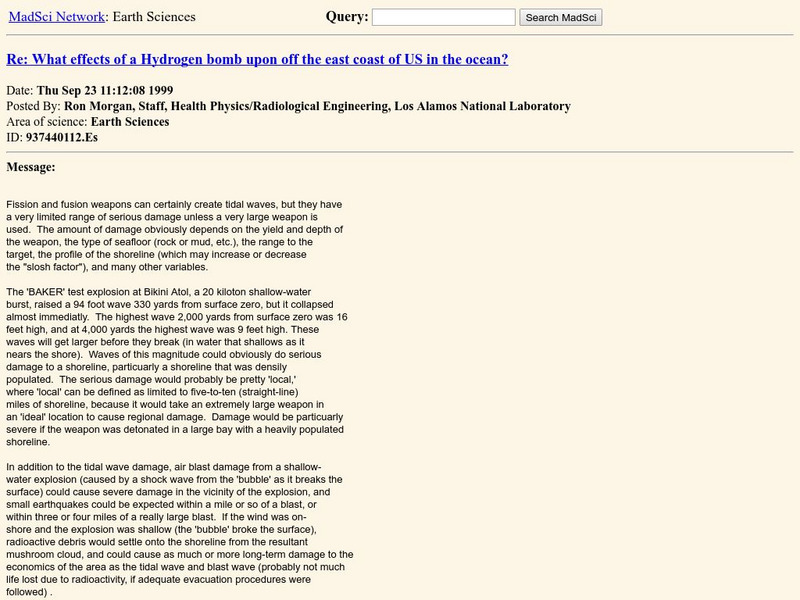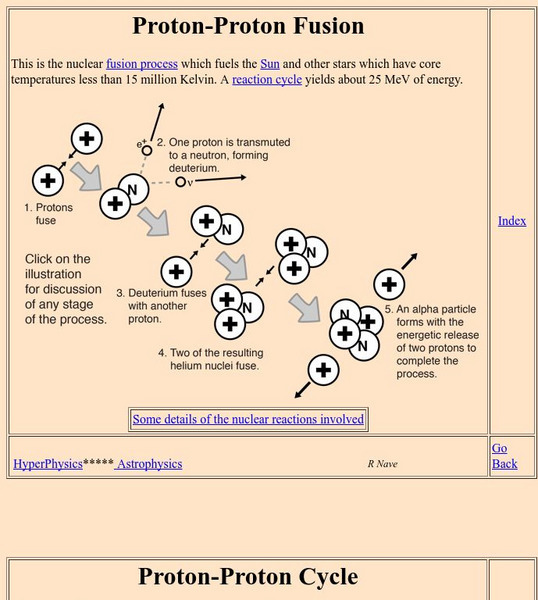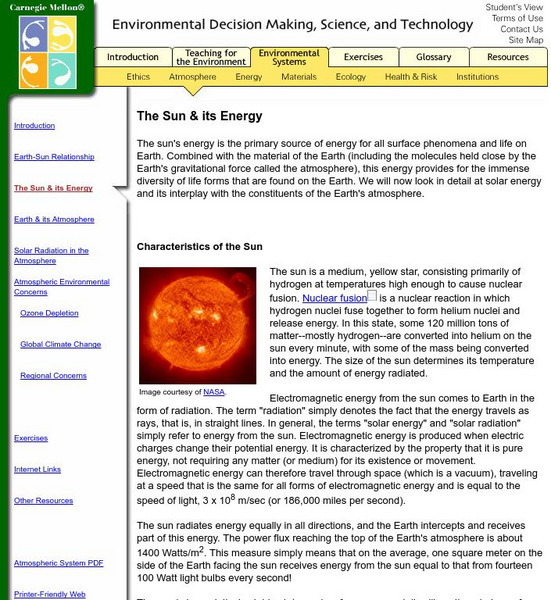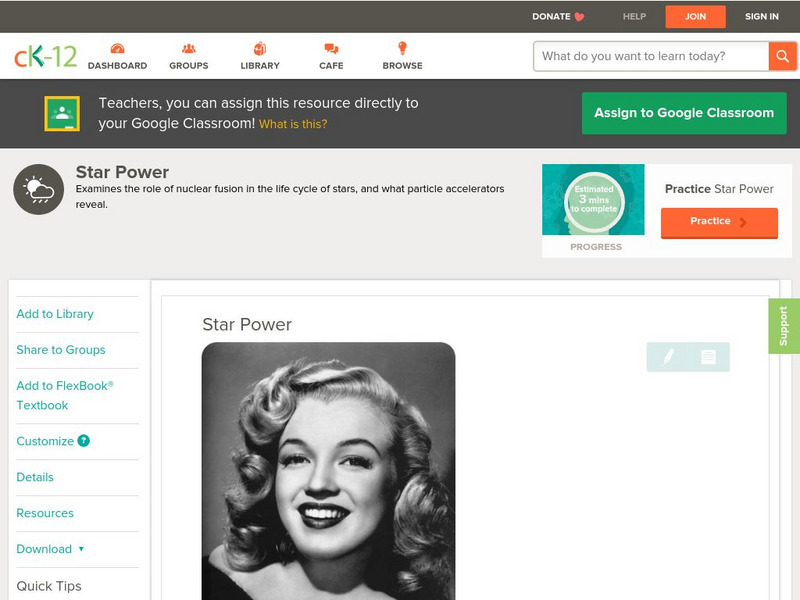NASA
Nasa: Exploring Climate Change
Test your knowledge of energy and its role in Earth's climate system with these interactive quizzes.
MadSci Network
Msn: What Are the Effects of a Hydrogen Bomb?
From the Mad Scientist Network web site. Using a question and answer format, this page describes some potential effects of a nuclear explosion. The possibilities of tidal waves, earthquakes and radiation-related damages are discussed.
Georgia State University
Georgia State University: Hyper Physics: Proton Proton Fusion
A look at the reaction that fuels the Sun with this diagram of the nuclear fusion process.
Carnegie Mellon University
Telstar: The Sun and Its Energy
The sun's energy is the primary source of energy for all surface phenomena and life on Earth. Combined with the material of the Earth (including the molecules held close by the Earth's gravitational force called the atmosphere), this...
Carnegie Mellon University
The Sun and Its Energy
The sun's energy is the primary source of energy for all surface phenomena and life on Earth. Combined with the material of the Earth (including the molecules held close by the Earth's gravitational force called the atmosphere), this...
Energy for Sustainable Development
Esd Bulgaria: Kids & Energy: Uranium (Nuclear)
Nuclear energy is energy in the nucleus of an atom. Atoms are tiny particles that make up every object in the universe. There is enormous energy in the bonds that hold atoms together. Nuclear energy can be used to make electricity. But...
Stanford University
Stanford Report: Edward Teller, Father of Hydrogen Bomb
Students don't generally learn much about Edward Teller in school. But with the progress in science in the 20th century, maybe they should. Edward Teller was one of the main architects of the hydrogen bomb. This is a great site by...
CK-12 Foundation
Ck 12: Earth Science: Outer Layers of the Sun
Identify the outer layers of the sun. [Free Registration/Login may be required to access all resource tools.]
CK-12 Foundation
Ck 12: Earth Science: Star Power
[Free Registration/Login may be required to access all resource tools.] Examines nuclear fusion in stars and simulated in particle accelerators.
CK-12 Foundation
Ck 12: Earth Science: Sun
[Free Registration/Login may be required to access all resource tools.] Provides an introduction of the sun's basic properties.
CK-12 Foundation
Ck 12: Earth Science: Interior of the Sun
Identify the layers of the Sun's interior. [Free Registration/Login may be required to access all resource tools.]
CK-12 Foundation
Ck 12: Earth Science: Interior of the Sun
[Free Registration/Login may be required to access all resource tools.] Identify the layers of the sun's internal structure.
NASA
Nasa Star Child: Stars
This page details the life cycle of a star, and includes information on medium-sized and massive stars, plus a glossary and a question.
NASA
Nasa Star Child: The Sun
Get to know our nearest star with this introduction to the sun. Listen to the information in an audio file. Vocabulary words are linked to a glossary of terms. Features include links to other interesting facts and a printable version of...
NASA
Nasa Star Child: Star Child
StarChild from NASA defines and describes the Solar System in a simple and easy-to-understand manner. The website is broken down into two versions for the student, grade school and junior high.
Other
Lcid: Comparison of Fission and Fusion Processes
From the Science Teacher's Resource Center. A data sheet tabulating the many differences between nuclear fission and nuclear fusion. Technical information about the nuclear reactions, the mass defect, isotope masses, etc. is included.
Other
Princeton Plasma Physics Laboratory: Fusion Basics
A wealth of background information on nuclear fusion and its potential use as a commercial energy resource. The advantages of nuclear fusion over other resources, the conditions required for its successful implementation and the future...
NASA
Nasa: The Sun's Energy Source
This site, which is provided by NASA, gives some scientific history and a clear and detailed explanation of nulcear forces and nuclear fusion.
Other
University of Leicester: Sun
Provides a brief overview of the Sun, including a focus on solar eclipses, solar wind, and solar sailing.
BBC
Bbc: Gcse Bitesize: The Life Cycle of a Star
This lesson focuses on the formation and life cycle of stars. Stars form when enough dust and gas clump together because of gravitational forces. Nuclear reactions release energy to keep the star hot. Some stars grow larger over time....
Utah State Office of Education
Utah State Office of Education: How Did the Universe and Solar System Develop?
Explore this unit to learn how the universe began. Through illustrations, videos, and classroom activities, gain an understanding of how stars help with the formation of elements.
CK-12 Foundation
Ck 12: Physical Science: Nuclear Fusion
[Free Registration/Login may be required to access all resource tools.] What nuclear fusion is and how and where it occurs. Using nuclear fusion to produce energy and its pros and cons.
CK-12 Foundation
Ck 12: Earth Science: Star Power
[Free Registration/Login may be required to access all resource tools.] Examines nuclear fusion in stars and simulated in particle accelerators.
CK-12 Foundation
Ck 12: Earth Science: Star Power Study Guide
[Free Registration/Login may be required to access all resource tools.] This study guide summarizes key points about the energy in stars. Includes a few questions to check for understanding.






















